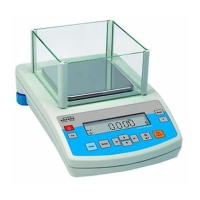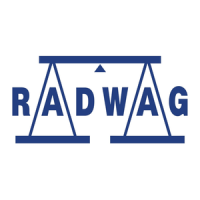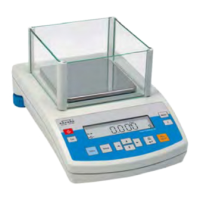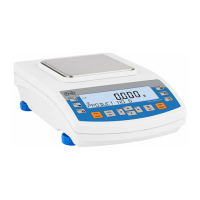
Do you have a question about the RADWAG PS/X series and is the answer not in the manual?
| Category | Scales |
|---|---|
| Brand | RADWAG |
| Series | PS/X |
| Type | Precision Balance |
| Display | LCD |
| Interface | RS-232, USB, Wi-Fi |
| Calibration | External |
| Protection class | IP 43 |
Defines the purpose and usage environment of the balance in laboratories.
Lists prohibited uses and potential damages to the balance.
Lists conditions under which the balance warranty is voided.
Explains the need for periodic inspection of balance's metrological characteristics.
Advises reading the manual carefully before assembly and startup.
Specifies that only trained and experienced personnel should operate the balance.
Instructions to check packaging for external damage upon delivery.
Guidelines for retaining original packaging for future transport and protecting components.
Details on storage and usage location requirements, temperature, stability, and grounding.
Steps for removing balance from packaging and assembling components.
Instructions on how to level the balance using adjusting feet and the built-in level.
Lists the items included in the standard balance package.
Provides instructions for cleaning the balance and cautions against damaging the measuring system.
Details on connecting the balance to the power supply using the correct adapter.
Guidelines for connecting external devices like printers or PCs, emphasizing unplugging first.
Explains the different elements and indicators shown on the balance's graphic display.
Describes the function of each key on the balance's keyboard.
Identifies the different sockets and interface ports on the balance.
Explains navigation using balance, PC keyboard, or virtual interface.
Explains how to navigate and edit options within the balance's user menu.
Explains the user login system, administrator/user roles, and password settings.
Details how automatic internal adjustment is triggered and the display content during calibration.
Explains how to perform an adjustment test by comparing internal adjustment weight with stored values.
Covers internal, external, and user adjustment procedures.
How to generate and print reports from adjustment processes.
How to set the date format (e.g., MM/DD/YYYY or DD/MM/YYYY).
How to set the time format (12-hour or 24-hour).
Step-by-step guide to setting the current time (hours, minutes, seconds).
Step-by-step guide to setting the current date (year, month, day).
Option to enable or disable time display on the balance's bargraph.
Option to enable or disable date display on the balance's bargraph.
How to adjust the filter value for operation based on ambient conditions.
Options for value release (fast, fast+reliable, reliable) affecting weighing time.
Setting the refresh rate of the display indication for optimal viewing.
Explains the autozero function for ensuring a precise zero point at the start of weighing.
Setting the display of the last digit for user comfort.
Enabling or disabling the display of negative mass values.
Setting balance operation based on ambient conditions (stable or unstable).
Setting 6-digit codes for specifying product, operator, batch, etc.
Option to print numeric codes automatically.
Enabling or disabling beep confirmation for key presses.
Selecting the language for the balance menu (Polish or English).
Enabling or disabling the display backlight for better visibility.
Adjusting the brightness of the graphic display.
Adjusting the contrast of the graphic display.
Enabling a screen saver that blanks the display after a set time.
Function to display the internal temperature measured by the sensor.
Displays the factory number of the balance for information.
Displays the software revision number operating in the balance.
Printing balance parameters set in the user menu.
Uploading parameters from a computer via RS 232.
Setting password access limits for Administrator and User.
Explains how to perform parts counting based on the mass of a single part.
Process for determining mass with set thresholds and monitoring via bargraph.
Precise measuring or adding product until a pre-defined target value is reached.
Comparing weighed load mass against a reference mass, displaying result in percentage.
Uses filters to determine mass of moving objects like animals.
Details components of a density kit and its application for solids and liquids.
Preparing mixtures according to pre-defined formulas, storing ingredient masses.
Calculating statistics (sum, mean, min, max) on prepared formulation mass.
Describes the standard printout format including measurement results and GLP variables.
Creating and editing custom printout templates.
Wiring diagrams for connecting balances to computers and printers.











